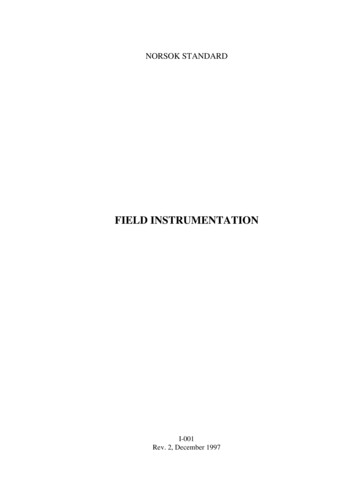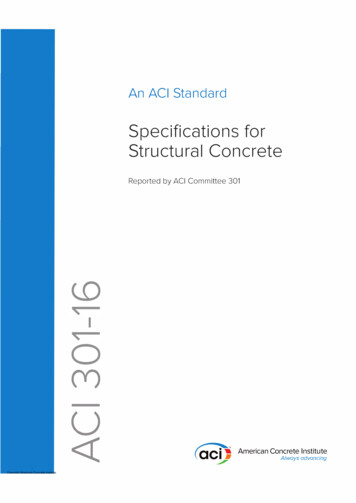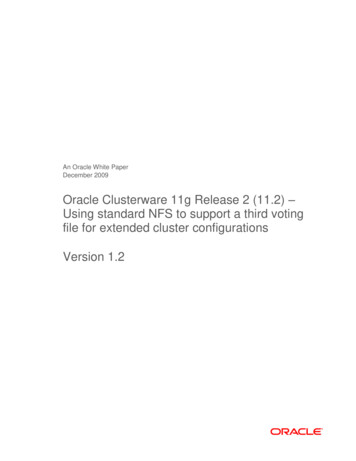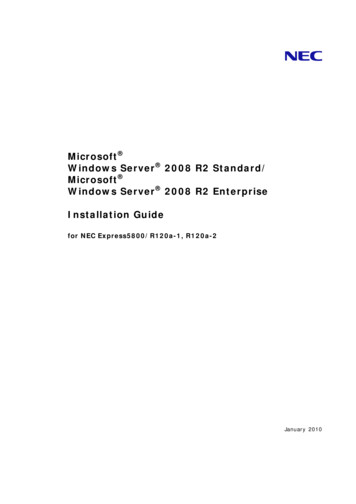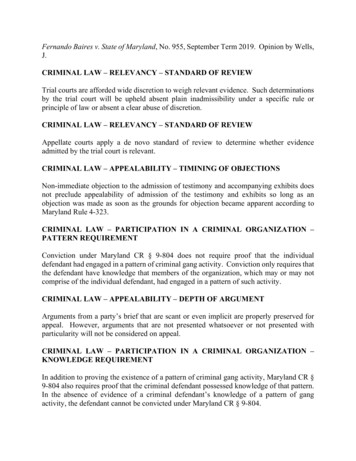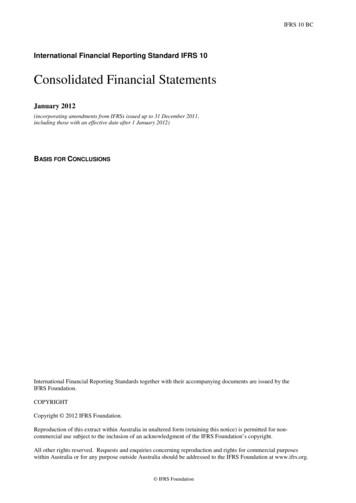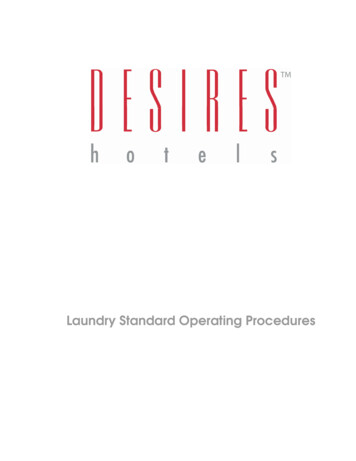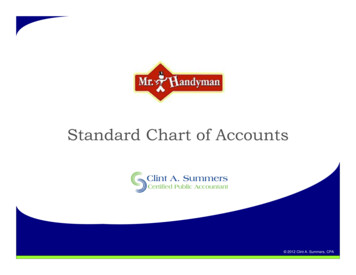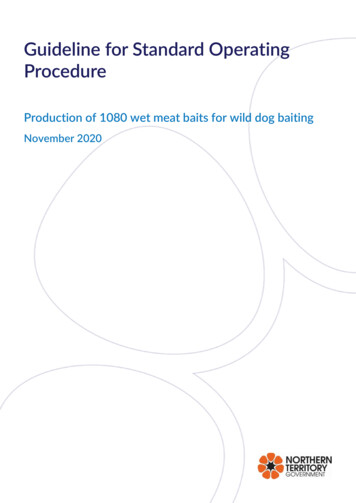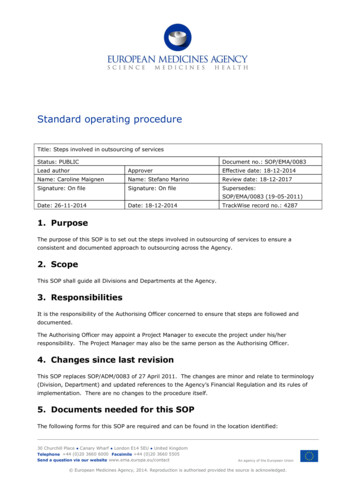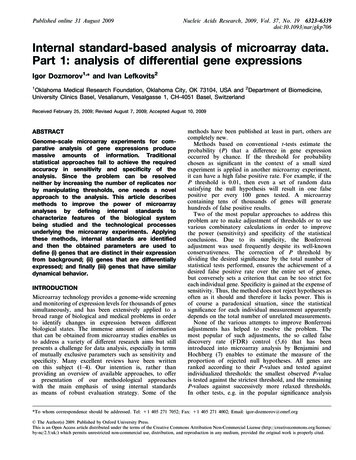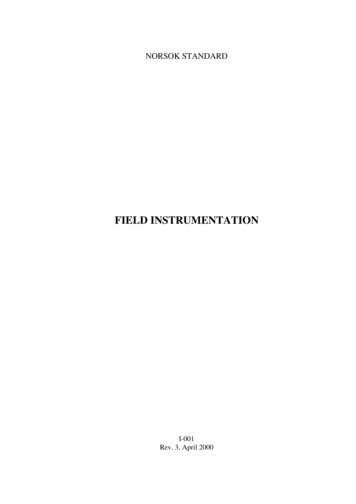
Transcription
NORSOK STANDARDFIELD INSTRUMENTATIONI-001Rev. 3, April 2000
This NORSOK standard is developed by NTS with broad industry participation. Please note thatwhilst every effort has been made to ensure the accuracy of this standard, neither OLF nor TBL orany of their members will assume liability for any use thereof. NTS is responsible for theadministration and publication of this standard.Norwegian Technology Standards InstitutionOscarsgt. 20, Postbox 7072 MajorstuaN-0306 Oslo, NORWAYTelephone: 47 22 59 01 00 Fax: 47 22 59 01 29Email: norsok@nts.no Website: http://www.nts.no/norsokCopyrights reserved
Field InstrumentationI-001Rev. 3, April 2000CONTENTSFOREWORDINTRODUCTION221 SCOPE32 NORMATIVE REFERENCES33 DEFINITIONS AND ABBREVIATIONS3.1 Definitions3.2 Abbreviations3.3 Engineering Units44444 FUNCTIONAL REQUIREMENTS4.1 Instrument Supplies4.2 Signal Types4.3 Instrument Design Principles4.4 Instrument Installation Design Principles4.5 Instrument Materials4.6 Air Supply Design4.7 Instrument Installation Bulk Materials4.8 Temperature Measurements4.9 Flow Measurements4.10 Pressure Measurement4.11 Level Measurement4.12 Control Valves4.13 Solenoid Valves4.14 Pressure Relief Valves/Bursting Discs4.15 On/Off Valve Actuators4.16 Choke Valves4.17 HVAC Actuators4.18 Vibration Field Instruments4.19 Fire & Gas Detectors5555678891010111212121314141414ANNEX A - LEVEL MEASUREMENT GUIDELINES (INFORMATIVE)16ANNEX B - INSTRUMENT AND PROCESS DATA SHEETS (NORMATIVE)17ANNEX C – DESCRIPTION FOR INSTRUMENT AND PROCESS DATA SHEETS(INFORMATIV)53NORSOK Standard1 of 153
Field InstrumentationI-001Rev. 3, April 2000FOREWORDNORSOK (The competitive standing of the Norwegian offshore sector) is the industry initiative toadd value, reduce cost and lead time and remove unnecessary activities in offshore fielddevelopments and operations.The NORSOK standards are developed by the Norwegian petroleum industry as a part of theNORSOK initiative and are jointly issued by OLF (The Norwegian Oil Industry Association) andTBL (Federation of Norwegian Engineering Industries). NORSOK standards are administered byNTS (Norwegian Technology Standards Institution).The purpose of this industry standard is to replace the individual oil company specifications for usein existing and future petroleum industry developments, subject to the individual company's reviewand application.The NORSOK standards make extensive references to international standards. Where relevant, thecontents of this standard will be used to provide input to the international standardisation process.Subject to implementation into international standards, this NORSOK standard will be withdrawn.Annex A is informative and B is normative.INTRODUCTIONThe revision 3 of this standard has been updated for new data sheets in Annex B, replacing the earlierIFEA-IDAS data sheets. A new Annex C is included to advice on how to use each specific data sheet.The main text in the standard is unchanged from Rev. 2.NORSOK Standard2 of 153
Field Instrumentation1I-001Rev. 3, April 2000SCOPEThe standard identifies the requirements to field instrumentation design.Note: Requirements for installation are found in NORSOK standard Z-010 "Installation of Electrical,Instrumentation and Telecommunication" and requirements for control system interface are found inI-CR-002 "Safety and Automation System".2NORMATIVE REFERENCESThe following standards include provisions, which, through references in this text, constituteprovisions of this NORSOK standard. Latest issue of the references shall be used unless otherwiseagreed. Other recognised standards may be used provided it can be shown that they meet or exceedthe requirements of the standards referenced below.ANSI B16.10ANSI B16.36ANSI/FCI 70-2ANSI/ASME B1.20.1ANSI/ASMEFace-to-face and end-to-end dimensions of valves.Steel orifice flangesControl valve seat leakage.Pipe threads general purpose (imperial units)Performance Test Codes 19.3 - 1974, chapter 1, section 8-19Thermowells.ANSI B16.5Pipe Flanges and Flanged FittingsAPI RP 520Sizing, Selection, and Installation Of Pressure-Relieving Devices inRefineries, Part I and II.API RP 526Flanged steel safety relief valves.API RP 527Seat Tightness of Pressure Relief Valves.API RP 670Vibration, axial position and bearing temperature system.API RP 678Accelerometer-based Vibration Monitoring System.ASME VIIIBoiler and pressure vessel code - Section VIII, Div. 1.BS 2915Bursting Discs and Bursting Disc DevicesEN 50081-2Electromagnetic compatibility generic emission standardEN 50082-2Electromagnetic compatibility generic immunity standardEN 60534-2-1/2 /IEC 534-2 Industrial process control valves. Part 2, section 1 and 2.EN 60584-1/2 /IEC 584-1 ThermocouplesEN 60751 /IEC 751Resistance Temperature Detectors (RTD)ISA 75.01Flow equations for sizing control valves.ISO 1000SI Units and recommendation for the use of their multiples and ofcertain other units.ISO 5167Measurement of fluid flow by means of pressure differentialdevices - Part 1.NAMURNormenarbeitsgemeinschaft für Mess- und Regelungstechnik in derChemischen IndustrieNFPA 72E 3-3Temperature ClassificationNORSOK Standard3 of 153
Field InstrumentationNORSOK L-002NORSOK L-CR-003NORSOK M-501I-001Rev. 3, April 2000Piping Design, Layout and Stress AnalysisPiping Details (will be renumbered L-003)Surface Preparation and Protective Coating3DEFINITIONS AND ABBREVIATIONS3.1ShallDefinitionsVerbal form used to indicate requirements strictly to be followed in order to conform tothe standard and from which no deviation is permitted, unless accepted by all involvedparties.ShouldVerbal form used to indicate that among several possibilities one is recommended asparticularly suitable, without mentioning or excluding others, or that a certain course ofaction is preferred but not necessarily required.MayVerbal form used to indicate a course of action permissible within the limits of thestandard.CanVerbal form used for statements of possibility and capability, whether material,physical or casual.The term instruments also include actuated valves and safety valves.3.2AbbreviationsGRPGlass fibre Reinforced PlasticHFHydrogen FluorideHVACHeating, Ventilation and Air ConditioningIFEAIndustriens Forening for Elektroteknikk og Automasjon(The Association for Electrical Technology and Automation in Industry)IRInfra RedLERLocal Equipment RoomNPTNational Pipe ThreadPtPlatinaRTDResistance Temperature DetectorSISystem InternationalTETemperature ElementTITemperature IndicatorUVUltra Violet3.3Engineering UnitsPressurebar, mbar, barg, baraLevelmm, % for indication (for guidelines ref. Annex A)Volume Flow m3/h (Flowing condition), Sm3/h (Standard condition ref. ISO 1000)Mass Flowkg/hTemperature Deg CFor other physical properties, SI units shall be utilised as per ISO 1000.NORSOK Standard4 of 153
Field Instrumentation4I-001Rev. 3, April 2000FUNCTIONAL REQUIREMENTS4.1Instrument SuppliesElectrical supply to instrument panels in LERs: 230V a.c. 50 Hz (standard) or 24V d.c.Electrical supply to field instruments: 24V d.c. (standard) or 230V a.c. 50Hz.Electrical supply to instrument field panels: 24V d.c. (standard) or 230V a.c. 50 Hz.Pneumatic ring main supply: Minimum 7 barg, maximum 10 barg.Pneumatic instrument supply: 1.4 barg (standard) or as required.Hydraulic ring main /instrument supply: Minimum 180 barg, maximum 210 barg.Hydraulic supply for wellhead/downhole depending on reservoir pressure.4.2Signal TypesThe following signal types shall be used:Analogue input/output: 2 wire, 4 - 20 mA.Digital input: Potentialfree contact.Digital output: 24 VDC.Signals between control systems and other panels shall be powered from platform control system.Position: Proximity switches with NAMUR interface.Pneumatic signals: 0.2 - 1.0 barg.Instrument field bus/digital communication may be used if the concept demonstrates economicalsavings and requirements to time response are satisfied.4.3Instrument Design PrinciplesInstrument performance/accuracy shall be sufficient to fulfil process/unit performance requirements.Variation of instrument types and ranges (e.g. thermowell lengths/transmitter ranges) shall be kept toa minimum.Analogue instruments shall be used for switch functions.Smart type instruments should be used. For each installation, the communication protocols shall beharmonised.NORSOK Standard5 of 153
Field InstrumentationI-001Rev. 3, April 2000Galvanic isolation barriers shall be used for I/O signals. These barriers should have full smart signaltransmission capability.For simple local control purposes only, the field instruments including controllers may be of apneumatic type.Where local indicators are required, local indicators and transmitters shall be combined. Separatelocal indicators may only be installed if necessary for local operation.Any arrangement of instruments shall allow for the removal of a sensor/detector head whilemaintaining the integrity of the other sensors, e.g. in addressable systems.Instruments shall meet requirements to EN 50081-2 and EN 50082-2 regarding electromagneticcompatibility.Flange connection for inline instruments shall follow piping class and specification ref. ANSI B16.5Pipe Flanges and Flanged Fittings.All in-line flow elements (when part of the process line) shall be flanged for removal from theprocess line.Pressure vessel design (e.g. accumulators for on/off valves) shall follow NORSOK standard L-002Piping Design, Layout and Stress Analysis.The most frequently used measuring principles are specified in separate sections of this document.Other types may be used on special applications.For field instruments not specifically dealt with in this standard, the design shall be based onrecognised international standards where applicable.4.4Instrument Installation Design PrinciplesPressure sensing instruments that can be clogged due to high viscosity fluids or hydrates or if themeasurement can be affected by other factors, shall be equipped with chemical seals.Pressure instruments shall have individual process isolation valves.Combined solutions may be used when not causing operational disadvantage/safety reduction duringservice of instruments etc.Each pressure instrument with process connection shall be fitted with instrument block /bleedmanifold (2/5 - way valve).Full functional independence between control and safety devices shall be assured, includingvessel/pipeline connections (e.g. common pressure tap for control and safety devices shall not beused).Use of combined manifolds for piping and instruments valves shall be evaluated. Combinedmanifolds should be used when instruments are direct mounted on or in the immediate vicinity of thepipe/vessel.NORSOK Standard6 of 153
Field InstrumentationI-001Rev. 3, April 2000Package suppliers shall terminate hydraulic and pneumatic tubing at skid edge with bulkhead maleconnectors or unions.Package suppliers shall terminate instrumentation cables in junction boxes at skid edge or at agreedtermination point.If safety and functional requirements are fulfilled, the following shall apply:Field instrument process connection: 1/2 " NPT ref. ANSI/ASME B1.20.1.Field instrument pneumatic connection: 1/4 " NPTField instrument hydraulic connection: 1/2" NPTField instrument cable entry: ISO threads - size depending on cable size.4.5Instrument MaterialsInstrument materials defined in this section shall apply. However, instruments may be specified withsuperior materials due to service requirements (particularly for internals).4.5.1 In-line InstrumentsControl valves, safety valves and other in-line instruments;- Body, bonnet, and bolts/nuts according to piping standard (Note).- Internals according to vendor recommendation.Note: Magnetic Flow Meter: SS Type 316 body with lining may be used. For operating temp. 60 ºC, body shall be painted according to NORSOK standard M-501 Surface Preparation andProtective Coating.Orifice plates, temperature wells etc. according to piping standard, but minimum 316 stainless steel.4.5.2 Off-line InstrumentsInstrument process wetted parts, tubing, tube fittings and bulk material:Piping Class MaterialCarbon SteelSS Type 316SS Type 6MoSS Type 22Cr DuplexTitaniumGRPNote 1Material Requirements 1) 2)Tm 60 ºC 3)SS Type 316SS Type 316TitaniumSS Type 316TitaniumTitaniumTm 60 ºC table replacement materials are UNS N10276 (Hastelloy C-276), UNS N06022(Hastelloy C-22) and UNS N06625 (Inconel 625). For seawater service, Inconel shall notbe used above 15 ºC and Hastelloy C shall not be used above 55 ºC.NORSOK Standard7 of 153
Field InstrumentationI-001Rev. 3, April 2000Note 2Titanium shall not be used for HF acid or pure Methanol service.Note 3Tm Material selection temperaturea)Instrument tubing, fittings etc. without heat tracing and/or insulation:Instrument side of isolation valve:If stagnant condition:Tm If circulation:Tm Off instrument side of isolation valve:Tm b)Operating temp. of the line to which theinstrument is connected reduced with 25 ºC.Applicable for the operating temp above25 ºC.Operating temp. of the line to which theinstrument is connected.Operating temp. of the line to which theinstrument is connected.Instrument tubing, fitting etc., with heat tracing and/or insulation:Tm Operating temp. of the line to which theinstrument is connected, or max. heat tracingoperation range, whichever is the highest.4.5.3 Instrument HousingInstrument housing shall be resistant to saline atmosphere.4.6Air Supply DesignFor users requiring filtered ring main pressure air supply, two air filters with isolation valves shall beprovided in parallel before a distribution manifold.For users requiring filtered reduced air supply, two air filter regulators with isolation valves shall beprovided before a distribution manifold. Each branch off shall be provided with a 1/2" isolationvalve.Minimum two spare branch off with valve and plug shall be provided for each manifold.Air manifolds shall be provide
API RP 520 Sizing, Selection, and Installation Of Pressure-Relieving Devices in Refineries, Part I and II. API RP 526 Flanged steel safety relief valves. API RP 527 Seat Tightness of Pressure Relief Valves. API RP 670 Vibration, axial position and bearing temperature system. API RP 678 Accelerometer-based Vibration Monitoring System. ASME VIII Boiler and pressure vessel code -
